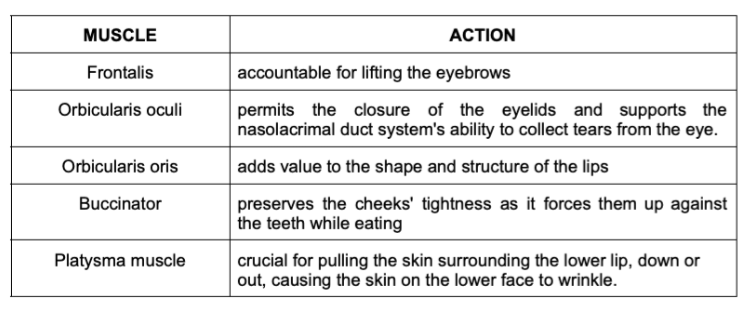This is patient AM, 28-year-old male who came in the ER because of drooping of his left face. He said he woke up and he could not move his left face.
He has no other muscle weakness. He is conscious and coherent although he had a little difficulty speaking because the left side of his lips drooped. He had normal blood pressure and he had no other comorbidities. He was diagnosed to have Bell’s palsy. Name 5 muscles which are affected and list its actions. Describe the mechanism of his muscle weakness. What other symptoms could the patient exhibit as a result of facial muscle weakness?
Five Muscles Affected and its Actions

Mechanism
Weakness is spawned from the inability to control the paralyzed side of the face when a certain individual is diagnosed with Bell's Palsy. Facial nerve experiencing inflammation produces compression along the constrained section of the fallopian canal, which is most likely the point of origination for Bell's palsy. Considering that it is initially translated in a brief loss of sensory or motor function, it has the tendency to subsequently culminate in permanent nerve degeneration (Zandian et al., 2014).
Symptoms
Apart from the ubiquitous symptom of Bell’s Palsy which is facial drooping, signs listed below may also indicate the aforementioned illness as per Cleveland Clinic (2020):
-
Speaking, eating, or drinking impairments.
-
Drooling
-
Eye dryness
-
Ear or facial discomfort
-
Headache
-
Decline in flavor
-
Tinnitus
-
Sound Sensitivity
References
Cleveland Clinic (2020). Bell’s Palsy. https://my.clevelandclinic.org/health/diseases/5457-bells-palsy
Pessino et al. (2021). Anatomy, Head and Neck, Frontalis Muscle. https://www.ncbi.nlm.nih.gov/books/NBK557752/#:~:text=The%20frontalis%20muscle%20is%20responsible,in%20middle%20cerebral%20artery%20strokes.
Sendic, G. (2022). Buccinator Muscle. https://www.kenhub.com/en/library/anatomy/buccinator-muscle
Sykes et al. (2018). Applied Facial Anatomy. https://www.sciencedirect.com/topics/neuroscience/orbicularis-oris-muscle#:~:text=The%20orbicularis%20oris%20muscle%20contributes,elevate%20and%20depress%20the%20lips.
Tong et al. (2021). Anatomy, Head and Neck, Eye Orbicularis Oculi Muscle. https://www.ncbi.nlm.nih.gov/books/NBK441907/#:~:text=Structure%20and%20Function,with%20winking%20and%20forced%20squeezing.
Zandian et al. (2014). The neurologist’s dilemma: A comprehensive clinical review of Bell’s palsy, with emphasis on current management trends. https://www.ncbi.nlm.nih.gov/pmc/articles/PMC3907546/#:~:text=The%20most%20probable%20mechanism%20of,nerve%20degeneration%20later%20%5B20%5D.